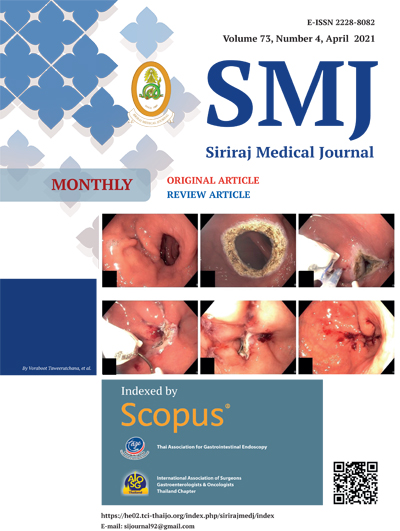Validity, Reliability and Responsiveness of the Thai Version of Patient-Rated Wrist Evaluation (Th-PRWE) in Distal Radius Fracture Patients
DOI:
https://doi.org/10.33192/Smj.2021.36Keywords:
Psychometric, patient outcome assessment, wrist injury, radius fractureAbstract
Objective: Patient-Rated Wrist Evaluation (PRWE) is a specific tool for the assessment of wrist function and has been validated and translated into many languages. This study aimed to translate the PRWE into the Thai language and to evaluate its validity, reliability, and responsiveness in operatively treated distal radius fracture patients.
Materials and Methods: PRWE was translated into the Thai language according to a linguistic validation protocol by a forward–backward translation process. In total, 53 distal radius fracture patients who underwent volar locking plate fixation were included in the present study. However, 8 patients were excluded due to multiple injuries, leaving 45 patients who were prospectively enrolled and evaluated with the Thai version of the PRWE (Th-PRWE) and Disabilities of the Arm, Shoulder, and Hand (DASH) questionnaire within 2 weeks of their surgery. Reliability of the Th-PRWE was assessed by the test–retest reliability and internal consistency. The content, concurrent, and criterion validity of the Th-PRWE were measured. At 3 months after the operation, patients were re-assessed with Th-PRWE and DASH. The standardized response mean (SRM) and effect size (ES) were assessed to identify the responsiveness to a change of the tool.
Results: Most of the patients were female (64%) with average age of 55 years old and had sustained distal radius fractures. The intraclass correlation for the test–retest reliability of the Th-PRWE was 0.9. The internal consistency of the Th-PRWE was acceptable (Cronbach’s alpha = 0.93). Th-PRWE had a high content validity (Item-objective congruence index = 0.8) and excellent correlation with DASH (Spearman’s rank correlation = 0.81; p < 0.001). Its responsiveness was also considered excellent (SRM = 1.12, ES = 1.28).
Conclusion: Th-PRWE is valid, reliable, and responsive for the evaluation of distal radius fracture patients.
Downloads
Published
How to Cite
Issue
Section
License
Authors who publish with this journal agree to the following conditions:
Copyright Transfer
In submitting a manuscript, the authors acknowledge that the work will become the copyrighted property of Siriraj Medical Journal upon publication.
License
Articles are licensed under a Creative Commons Attribution-NonCommercial-NoDerivatives 4.0 International License (CC BY-NC-ND 4.0). This license allows for the sharing of the work for non-commercial purposes with proper attribution to the authors and the journal. However, it does not permit modifications or the creation of derivative works.
Sharing and Access
Authors are encouraged to share their article on their personal or institutional websites and through other non-commercial platforms. Doing so can increase readership and citations.














